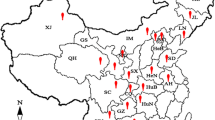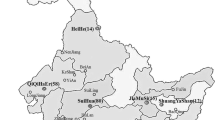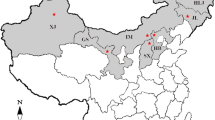Abstract
Potato stem canker caused by Rhizoctonia solani commonly occurs in potato-growing regions around the world, but little is known about whether binucleate Rhizoctonia (BNR) can incite this disease on potato plants in China. In the present study, a total of 69 BNR isolates were recovered from cankered subterraneous stems of potato collected from 17 provinces, autonomous regions, and municipalities of China. Based on the morphological characteristics and sequence analysis of the internal transcribed spacers of the ribosomal DNA, 48 isolates were classified as anastomosis group (AG)-A with a ratio of 69.56 %, 15 isolates (21.74 %) were AG-K, four isolates (5.80 %) were AG-F, one isolate (1.45 %) was AG-I and one isolate (1.45 %) was AG-U. Pathogenicity tests under glasshouse conditions revealed that all BNR isolates, except for the AG-I isolate, could induce symptoms of stem canker on potato plants with disease incidence ranging from 5.26 to 55.56 % and disease index ranging from 1.32 to 13.89, respectively. To our knowledge, this is the first detailed report about BNR AGs causing stem canker on potato plants in China.


Similar content being viewed by others
References
Aiello, D., Vitale, A., Hyakumachi, M., & Polizzi, G. (2012). Molecular characterization and pathogenicity of binucleate Rhizoctonia AG-F associated to the watermelon vine decline in Italy. European Journal of Plant Pathology, 134, 161–165.
Balali, G. R., Neate, S. M., Scott, E. S., Whisson, D. L., & Wicks, T. J. (1995). Anastomosis group and pathogenicity of isolates of Rhizoctonia solani from potato crops in South Australia. Plant Pathology, 44, 1050–1057.
Bandy, B. P., Leach, S. S., & Tavantzis, S. M. (1988). Anastomosis group 3 is the major cause of Rhizoctonia disease of potato in Maine. Plant Disease, 72, 596–598.
Banville, G. J. (1989). Yield losses and damage to potato plants caused by Rhizoctonia solani Kühn. American Potato Journal, 66, 821–834.
Burpee, L. L., Sanders, P. L., Cole, H., & Sherwood, R. T. (1980). Pathogenicity of Ceratobasidium cornigerum and related fungi representing five anastomosis groups. Phytopathology, 70, 843–846.
Campion, C., Chatot, C., Perraton, B., & Andrivon, D. (2003). Anastomosis groups, pathogenicity and sensitivity to fungicides of Rhizoctonia solani isolates collected on potato crops in France. European Journal of Plant Pathology, 109, 983–992.
Carling, D. E. (1996). Grouping in Rhizoctonia solani by the anastomosis reaction. In B. Sneh, S. Jabaji-Hare, S. Neate, & G. Dijst (Eds.), Rhizoctonia species: Taxonomy, molecular biology, ecology, pathology and disease control (pp. 37–47). Dordrecht: Kluwer Academic Publishers.
Carling, D. E., Kuninaga, S., & Brainard, K. A. (2002). Hyphal anastomosis reactions, rDNA-internal transcribed spacer sequences, and virulence levels among subsets of Rhizoctonia solani anastomosis group-2 (AG-2) and AG-BI. Phytopathology, 92, 43–50.
Carling, D. E., & Leiner, R. H. (1986). Isolation and characterization of Rhizoctonia solani and binucleate Rhizoctonia solani-like fungi from aerial stems and subterranean organs of potato plants. Phytopathology, 76, 725–729.
Carling, D. E., & Leiner, R. H. (1990). Effect of temperature on virulence of Rhizoctonia solani and other Rhizoctonia on potato. Phytopathology, 80, 930–934.
Carling, D. E., Leiner, R. H., & Kebler, K. M. (1987). Characterization of a new anastomosis group (AG-9) of Rhizoctonia solani. Phytopathology, 77, 1609–1612.
Carling, D. E., Leiner, R. H., & Westphale, P. C. (1989). Symptoms, signs and yield reduction associated with Rhizoctonia disease of potato induced by tuber-borne inoculum of Rhizoctonia solani AG-3. American Potato Journal, 66, 693–701.
Carling, D. E., Brainard, K. A., Virgen-Calleros, G., & Olalde-Portugal, V. (1998). First report of Rhizoctonia solani AG-7 on potato in Mexico. Plant Disease, 82, 127.
Ceresini, P. C., Shew, H. D., Vilgalys, R. J., & Cubeta, M. A. (2002). Genetic diversity of Rhizoctonia solani AG-3 from potato and tobacco in North Carolina. Mycologia, 94, 437–449.
Copes, W. E., Rodriguez-Carres, M., Toda, T., Rinehart, T. A., & Cubeta, M. A. (2011). Seasonal prevalence of species of binucleate Rhizoctonia fungi in growing medium, leaf litter, and stems of container-grown Azalea. Plant Disease, 95, 705–711.
Eken, C., & Demirci, E. (2003). Identification and pathogenicity of Rhizoctonia solani and binucleate Rhizoctonia anastomosis groups isolated from forage legumes in Erzurum, Turkey. Phytoparasitica, 31, 76–80.
Fang, X. L., Finnegan, P. M., & Barbetti, M. J. (2013). Wide variation in virulence and genetic diversity of binucleate Rhizoctonia isolates associated with root rot of strawberry in Western Australia. PLoS ONE, 8, E55877.
González, V., Portal, M. A., & Rubio, V. (2006). Biology and systematics of the form genus Rhizoctonia. Spanish Journal of Agricultural Research, 4, 55–79.
Hyakumachi, M., Priyatmojo, A., Kubota, M., & Fukui, H. (2005). New anastomosis groups, AG-T and AG-U, of binucleate Rhizoctonia spp. causing root and stem rot of cut-flower and miniature roses. Phytopathology, 95, 784–792.
Jing, Y., Li, X. N., & Yu, J. F. (2012). Anastomosis groups of Rhizoctonia solani from cotton in northern China. Mycosystema, 31, 540–547 (In Chinese).
Khangura, R. K., Barbetti, M. J., & Sweetingham, M. W. (1999). Characterization and pathogenicity of Rhizoctonia species on canola. Plant Disease, 83, 714–721.
Kronland, W. C., & Stanghellini, M. E. (1988). Clean slide technique for the observation of anastomosis and nuclear condition of Rhizoctonia solani. Phytopathology, 78, 820–822.
Lehtonen, M. J., Ahvenniemi, P., Wilson, P. S., German-Kinnari, M., & Valkonen, J. P. T. (2008). Biological diversity of Rhizoctonia solani (AG-3) in a northern potato-cultivation environment in Finland. Plant Pathology, 57, 141–151.
Martin, S. B. (1988). Identification, isolation frequency, and pathogenicity of anastomosis groups of binucleate Rhizoctonia spp. from strawberry roots. Phytopathology, 78, 379–384.
Miles, T. D., Woodhall, J. W., Miles, L. A., & Wharton, P. S. (2013). First report of a binucleate Rhizoctonia (AG-A) from potato stems infecting potatoes and sugar beet in the Pacific Northwest. Resource document. Plant Disease, 97, 1657.
Misawa, T., & Toda, T. (2013). First report of black scurf on carrot caused by binucleate Rhizoctonia AG-U. Journal of General Plant Pathology, 79, 86–88.
Rinehart, T. A., Copes, W. E., Toda, T., & Cubeta, M. A. (2007). Genetic characterization of binucleate Rhizoctonia species causing web blight on azaleain Mississippi and Alabama. Plant Disease, 91, 616–623.
Sharon, M., Freeman, S., Kuninaga, S., & Sneh, B. (2007). Genetic diversity, anastomosis groups and virulence of Rhizoctonia spp. from strawberry. European Journal of Plant Pathology, 117, 247–265.
Sharon, M., Kuninaga, S., Hyakumachi, M., Naito, S., & Sneh, B. (2008). Classification of Rhizoctonia spp. using rDNA-ITS sequence analysis supports the genetic basis of the classical anastomosis grouping. Mycoscience, 49, 93–114.
Strausbaugh, C. A., Eujayl, I. A., Panella, L. W., & Hanson, L. E. (2011). Virulence, distribution and diversity of Rhizoctonia solani from sugar beet in Idaho and Oregon. Canadian Journal of Plant Pathology, 33, 210–226.
Thompson, J. D., Higgins, D. G., & Gibson, T. J. (1994). CLUSTAL W: improving the sensitivity of progressive multiple sequence alignment through sequence weighting, position-specific gap penalties and weight matrix choice. Nucleic Acids Research, 22, 4673–4680.
Tsror, L. (2010). Biology, epidemiology and management of Rhizoctonia solani on potato. Journal of Phytopathology, 158, 649–658.
Virgen-Calleros, G., Olalde-Portugal, V., & Carling, D. E. (2000). Anastomosis groups of Rhizoctonia solani on potato in central Mexico and potential for biological and chemical control. American Journal of Potato Research, 77, 219–224.
Wang, P. P., & Wu, X. H. (2012). First report of sugar beet seedling damping-off caused by binucleate Rhizoctonia AG-A in China. Plant Disease, 96, 1696.
White, T. J., Bruns, T., Lee, S., & Taylor, J. (1990). Amplification and direct sequencing of fungal ribosomal RNA genes for phylogenetics. In M. A. Innis, D. J. Gelfand, J. J. Sninsky, & T. J. White (Eds.), PCR protocols: A guide to methods and applications (pp. 315–322). New York: Academic.
Woodhall, J. W., Lees, A. K., Edwards, S. G., & Jenkinson, P. (2007). Characterization of Rhizoctonia solani from potato in Great Britain. Plant Pathology, 56, 286–295.
Woodhall, J. W., Webb, K. M., Harper, G., Peters, J. C., Rodriguez-Carres, M., & Cubeta, M. A. (2011). First report of a new binucleate Rhizoctonia on potato tubers in the UK. New Disease Reports, 23, 31.
Woodhall, J. W., Belcher, A. R., Peters, J. C., Kirk, W. W., & Wharton, P. S. (2012a). First Report of Rhizoctonia solani AG2-2IIIB infecting potato stems and stolons in the United States. Plant Disease, 96, 460.
Woodhall, J. W., Wharton, P. S., & Peters, J. C. (2012b). First report of Rhizoctonia solani AG4 HG-II infecting potato stems in Idaho. Plant Disease, 96, 1701.
Woodhall, J. W., Adams, I. P., Peters, J. C., Harper, G., & Boonham, N. (2013). A new quantitative real-time PCR assay for Rhizoctonia solani AG3-PT and the detection of AGs of Rhizoctonia solani associated with potato in soil and tuber samples in Great Britain. European Journal of Plant Pathology, 136, 273–280.
Yanar, Y., Yllmaz, G., Cesmeli, I., & Coskun, S. (2005). Characterization of Rhizoctonia solani isolates from potatoes in Turkey and screening potato cultivars for resistance to AG-3 isolates. Phytoparasitica, 33, 370–376.
Yang, Y. G., & Wu, X. H. (2012). First report of potato stem canker caused by Rhizoctonia solani AG-5 in China. Plant Disease, 96, 1579.
Yang, Y. G., & Wu, X. H. (2013a). First report of potato stem canker caused by binucleate Rhizoctonia AG-A in Jilin Province, China. Plant Disease, 97, 1246.
Yang, Y. G., & Wu, X. H. (2013b). First report of potato stem canker caused by Rhizoctonia solani AG4 HGII in Gansu Province, China. Plant Disease, 97, 840.
Yang, G. H., Chen, H. R., Naito, S., Ogoshi, A., & Deng, Y. L. (2005). First report of AG-A of binucleate Rhizoctonia in China, pathogenic to soya bean, pea, snap bean and pak choy. Journal of Phytopathology, 153, 333–336.
Acknowledgments
We are grateful to N. Kondo from Hokkaido University for kindly providing the reference strains. This work was supported by Program for Changjiang Scholars and Innovative Research Team in University (No. IRT1042). Mention of trade names or commercial products in this report is solely for the purpose of providing specific information and does not imply recommendation or endorsement.
Author information
Authors and Affiliations
Corresponding author
Rights and permissions
About this article
Cite this article
Yang, Y., Zhao, C., Guo, Z. et al. Anastomosis groups and pathogenicity of binucleate Rhizoctonia isolates associated with stem canker of potato in China. Eur J Plant Pathol 139, 535–544 (2014). https://doi.org/10.1007/s10658-014-0409-6
Accepted:
Published:
Issue Date:
DOI: https://doi.org/10.1007/s10658-014-0409-6




